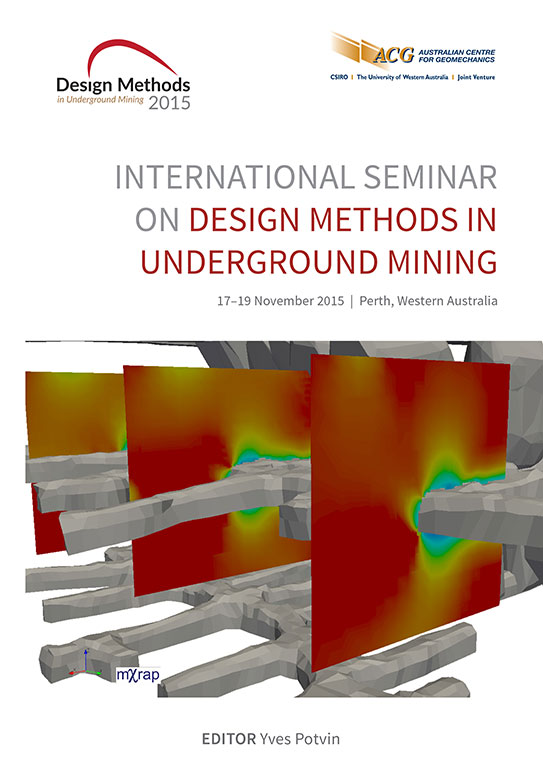Guidelines for orepass design in a sublevel cave mine

|
Authors: Bunker, KA; Campbell, AD; O’Toole, D; Penney, A |
DOI https://doi.org/10.36487/ACG_rep/1511_37_Bunker
Cite As:
Bunker, KA, Campbell, AD, O’Toole, D & Penney, A 2015, 'Guidelines for orepass design in a sublevel cave mine', in Y Potvin (ed.), Design Methods 2015: Proceedings of the International Seminar on Design Methods in Underground Mining, Australian Centre for Geomechanics, Perth, pp. 585-600, https://doi.org/10.36487/ACG_rep/1511_37_Bunker
Abstract:
Underground mines commonly use orepass systems as a safe and economic method to transport broken rock between levels. Although these systems are an integral part of such operations, design methodologies are generally limited to empirical methods, rules of thumb and limited case studies. This paper details orepass design issues in an operating sublevel cave (SLC) mine and the method used to determine suitable design parameters for future orepasses at the mine. The guidelines, as well as the system used to determine the parameters, can be used as a design methodology applicable to any other mine at a planning or operational stage. Operational issues during early orepass operation included hangups due to cohesive arching and ore compaction, and higher than forecasted wear rates. The operational and financial implications of these issues have necessitated the need to develop site based guidelines for orepass design and layout. Laboratory testing and statistical analysis were conducted in conjunction with empirical methods to determine optimum orepass diameter, inclination angle, pass length and tipping methodology. Wear rates have been measured for different tipping methods and used to provide an estimate for orepass longevity. Forecast wear rates for planned throughput have then been analysed to calculate maximum stable pass dimensions. Numerical modelling was utilised to determine suitable standoff distances between other orepasses, development and the SLC footprint. Regular monitoring was used to calibrate theoretical wear rates with actual measurements. This paper outlines how orepass design guidelines have been developed for the Ernest Henry SLC. Empirical methods and numerical analyse have been undertaken to determine guidelines which have been progressively calibrated using monitoring data and field observations.
References:
Brummer, R 1998, ‘Design of orepasses – methods for determining the useful life of orepasses based on previous experience and case studies’, final report, prepared for the Canadian Mining Industry Research Organization (CAMIRO) mining division, Sudbury, ON.
Hadjigeorgiou, J & Mercier-Langevin, F 2008, ‘Estimating ore pass longevity in hard rock mines’, in F Tonon (ed.), Proceedings of the 42nd US Rock Mechanics Symposium, American Rock Mechanics Association, Alexandria, VA, 8 p.
Hadjigeorgiou, J, Lessard, J & Mercier-Langevin, F 2005, ‘Orepass practice in Canadian mines’, Journal of the Southern African Institute of Mining and Metallurgy, vol. 105, no. 11, pp. 809-817.
Hambley, DF 1987, ‘Design of orepass systems for underground mines’, Bulletin of the Canadian Institute of Mining, Metallurgy and Petroleum, vol. 80, no. 897, pp. 25-30.
Hambley, DF, Pariseau, WG & Singh, MM 1983, ‘Guidelines for open-pit orepass design’, report, prepared for the US Bureau of Mines, Washington DC.
Iverson, SR & Jung, SJ 2005, ‘Mechanism of cohesive hang-up in orepass’, in DP Yale (ed.), Proceedings of the 40th US Symposium on Rock Mechanics (USRMS), American Rock Mechanics Association, Minneapolis, pp. 25-29.
McCracken, A & Stacey, TR 1989, ‘Geotechnical risk assessment of large diameter raisebored shafts’, Transaction of the Institution of Mining and Metallurgy, vol. 98, pp. A145-A150.
Mogi, G, Yamatomi, J & Adachi, T 1995, ‘An expert system controlling ore flow in large scale orepass systems’, Proceedings of the 4th International Symposium on Mine Planning and Equipment Selection, A.A. Balkema, Rotterdam, pp. 169-175.
O’Toole, D 2014, Ernest Henry Mine review of orepass flow and longevity, internal publication, pitt&sherry, Hobart.
Russell, A 2014, Laboratory investigation – triaxial testing of an ore material at different moisture contents, internal publication, University of New South Wales, Sydney.
Stacey, TR & Erasmus, BJ 2005, ‘Setting the scene: rockpass accident statistics and general guidelines for the design of rockpasses’, Journal of the Southern African Institute of Mining and Metallurgy, vol. 105, no. 11, pp. 745-752.
© Copyright 2026, Australian Centre for Geomechanics (ACG), The University of Western Australia. All rights reserved.
View copyright/legal information
Please direct any queries or error reports to repository-acg@uwa.edu.au
View copyright/legal information
Please direct any queries or error reports to repository-acg@uwa.edu.au